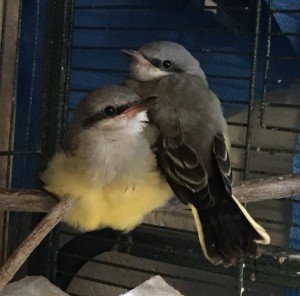Western Kingbirds—Little tyrants in the bird nursery!
Western Kingbirds are common flycatchers found primarily in rural residential areas and lowland riparian woodlands in our area. In all, the U.S. has 7 different species of kingbird, including several quite rare visitors to southern Arizona and the Texas/Mexico border. Western Kingbirds live in Colorado between May and September, heading to southern Mexico and Central America in early fall. They can often be spotted sitting on utility wires, scanning for food. Here’s a photo of an adult in a classic kingbird pose. A member of a vast family of species called Tyrant flycatchers (more than 420 species and found only in the western hemisphere!), the derivation of the Western Kingbird’s scientific name—Tyrannus verticalis—reveals a hidden characteristic of these feisty birds. The genus name (Tyrannus) is easy: From Greek, then Latin, for “absolute ruler,” all kingbirds put up a noisy and vigorous territorial defense of their small “kingdoms,” attacking hawks, ravens, cats, and whatever else wanders in. The species name (verticalis), though, is a bit of a puzzle. Might it refer to their very upright perching posture? No, all kingbirds sit that way. Actually, it comes from the deeper roots of the term “vertical,” which in Latin is “vertex”—crown of the head. Adult Western Kingbirds have a unique small orange-red patch on the midcrown, which is rarely seen. One photographer got a really lucky shot of the patch; scroll down to the 5th photo. Western Kingbirds have not been common visitors at Greenwood. (In 2014, we had only 2 adults, 5 fledglings, and 4 nestlings.)
A flycatcher has a much simpler syrinx—the avian version of our larynx, the sound-producing structure in the respiratory track—so its songs and calls are much less complex than those of most other songbirds. Flycatchers are in the “suboscine” group—meaning, a bit arrogantly, I’d say, “less than oscines” (which are the songbirds). Suboscines don’t learn their songs by hearing adults sing, as the oscines do; they’re born knowing them. (Click here—scroll down to “typical voice”—to hear this vocalization. It reminds me of a irritated, chattering mouse—if mice chattered.) They eat primarily flying insects (flies, bees, wasps, ants, grasshoppers) as well as fruit and berries. As do many other flycatchers, Western Kingbirds will often perch on a bare branch or wire, swooping out 40-60 feet in pursuit of insects and returning to the exact same spot to continue the hunt—referred to, very handily, as “flycatching.” This trait can be very helpful if you’re trying to get a good look at one in the wild—you often get multiple tries!
Young Western Flycatchers fledge after about 16 days in the nest, but they depend on their parents for 2-3 weeks after that, while they hone their flying skills and learn to catch insects. Here’s a photo of an adult in a blur of feeding fledglings. One summer along the Highline Canal bike trail in Denver, my husband and I watched a parent Western Kingbird feeding 2 very noisy young fledglings. The kids waited impatiently on a branch; the parent zoomed in with a mouthful of insects but landed on a different branch than they were on—probably encouraging them to figure out the art of flying. Once they get that skill honed, the parents will likely show up with wounded insects and drop them from above, forcing the kids to sally forth and catch the insects mid-air. On-the-job training for a new generation of “little tyrants!”

